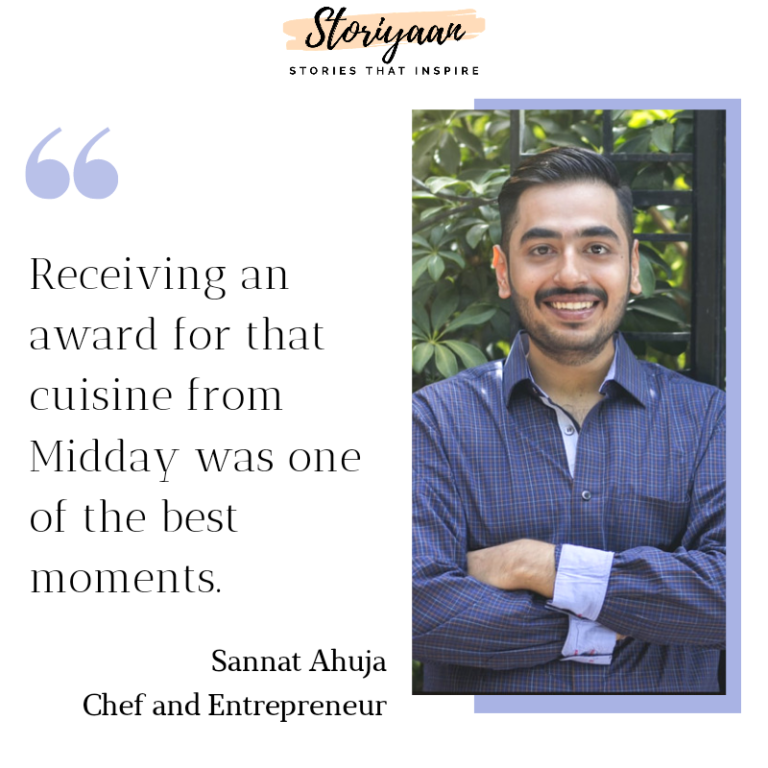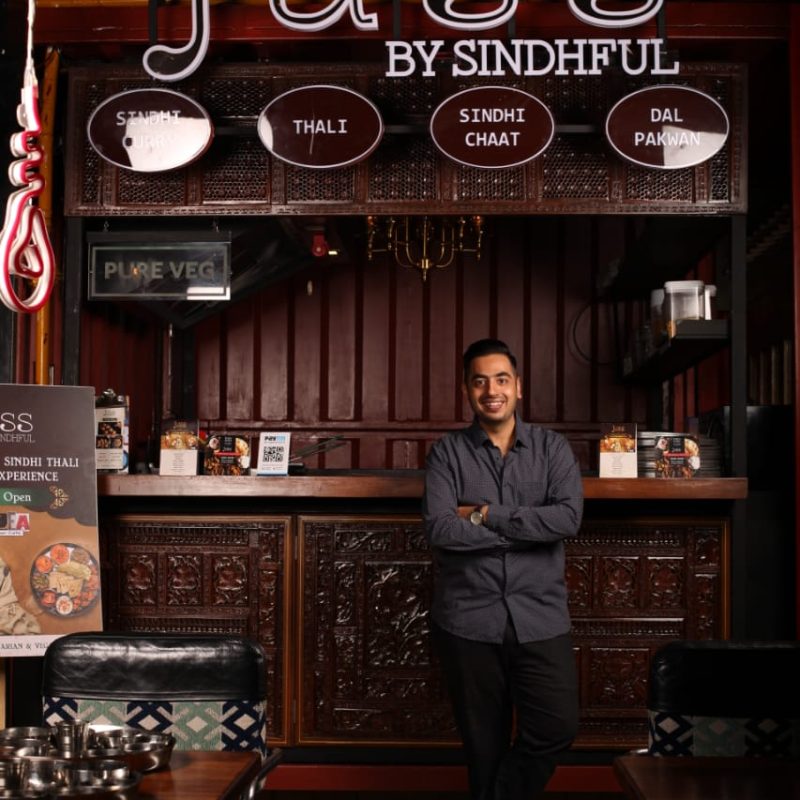Sannat Ahuja did his graduation in business management and real estate and has worked with JLL before he started ‘Sindhful’ – a platter of Sindhi cuisines. He derived his inspiration from his mother and learned that Sindhi food is scarcely available and that only a few dishes were sold at limited places.
Sindhful started their first outlet at Khar West in 2017 and since then they haven’t looked back. Bagging the award for the Best Takeaway in 2018, they have catered to a variety of celebrity weddings including Ranveer Singh and Deepika Padukone’s wedding in Italy and the Ambani wedding at Jio Gardens.
Sindhful has now opened their restaurant ‘Juss’ where anyone can walk in to experience Sindhi delight. Learn what Sannat has to say about Sindhful in a conversation with Team Storiyaan.

Interview
Questions and answers
Talk to us about leaving a secure job and entering a different industry altogether.
I always wanted to achieve something in the food industry. I wanted to start with it as soon as my college was over, but I did not have the capital for it. Then, I decided to work for some time and save money. I had a secure corporate job at JLL. Although I was doing great and earning well, I did not love the work. I was not enjoying it. There was a voice in my head telling me to pursue my idea. At the same time, it was destructive for me as I did not know if it was profitable or would the idea even work out. But, I knew I would be proud as I tried, not leaving the opportunity. I am thankful I took the decision.
Could you tell us about the moment when you realized that the things were worth picking up?
We came from a dark kitchen or now called cloud kitchen. It was rare in 2016. We tried to minimize the risk and rented out a small shop at the back end of the road for 30000. We connected with chefs from different parts of India and trained them. We received a call from ‘Midday’ as they wanted to interview me and the article got published on the next day. The word started spreading out, and now other publications also wanted to do that. We were getting noticed, and people enjoyed the food. That was the moment I could see things were picking up. Since the space was small, there was uncertainty with regards to the completion of orders. But people enjoyed the delivery model. It was a great moment for us.
You mentioned when things started looking up; there were too many orders to be completed which were beyond your manual capacity. How did you cope up with the pressure and come through?
The orders had started flowing to a great extent. By the time it was Tuesday or Thursday, I had to think about the upcoming Friday as there would be 80 – 90 orders and we had only two workstations with a limited number of people. We would give a 2 hour notice for the unusual orders. Even on delivery apps, we took orders until 7:30 pm. We would wrap up by 10 pm in this way. I took the call to rent a bigger space in 2016. We shifted from 4 guys to 25 guys because we could not cope up. We had limited capacity and equipment of our work station.
How did you expand the array of your dishes from the initial phase to today?
New dishes are challenging to make in a restaurant format. The gravy we prepare needs to be slow-cooked, unlike in restaurants where they have three sauces and need to mix as per dishes. So, by 11 am, every morning we prepare the curries that get sold by afternoon. It is difficult for us to add more recipes, but we had a few additions right now. People don’t get accustomed to many new dishes that they haven’t tried. They might try it once for taste. So we have to remove that. Not necessarily all of them would not work, but we always try to add meals to the menu that people haven’t tried.
Can you tell us about the moment when you received the Midday Guide award for Best takeaway in 2018?
No one has ever created a segment for cuisine. Receiving an award for that cuisine from Midday was one of the best moments. It feels like now are on the top list of brands for restaurants doing well. I cannot express in words altogether. That was the time when I sensed that we are doing great. People started noticing us more. People living in Andheri, Mahim and a few more areas wanted to come and try the food. We wanted a dining space for people to try our food, and this award helped us to get confidence and do that.
Tell us about your transition from restaurant takeaways to catering services.
Initially, we had no plans, but later we realized that there would be many groundbreaking achievements in catering formats. Generally, Sindhi food was catered and confined to Sindhi occasions and rituals. We thought of expanding the reach of Sindhi food. We got a few catering opportunities after which our catering services were in demand. We supplied for small occasions initially with 30-40 people and later increased it to 250-300 people. We knew that our catering services would do a fabulous job, but we had other concerns regarding infrastructure, workstation people, finances, entities and logistics. So by the time, we were providing catering services, we were ready to do it. We didn’t find it that difficult to manage it the whole process.
Travelling along with catering for DeepVeer's Wedding, how did you prepare for it?
When this order of wedding came to us, we couldn’t believe it. The process of selection of our brand for their wedding was so private that we didn’t know whom we were serving until they did the final round for tasting the food. The whole affair was so secret that we weren’t even allowed to carry our mobiles phones to Italy. It was thus challenging to get the vegetables, masalas and ingredients we needed. However, the hotel management and people from Food Link company helped and cooperated with us. We got positive feedback from people out there. Ranveer Singh too commented about our food, especially on the Dal Pakwaan.
Talk to us about the genesis of Sindhful.
We thought a lot for ‘Sindhful’. I knew that Sindhi food is never tried out or spoken about before. The Sindhi people who could make this food was the limitation of the taste buds of this food. The other population rarely found Sindhi food palatable. It was not as spicy as Tandoor, Chinese and North Indian dishes. So, it was a huge risk to take, but somehow I followed my intuition. I wanted people to appreciate the simplicity, uniqueness and deliciousness of Sindhi food. However, creating the menu took many efforts. We had to do this while keeping the various ideas of tastes of the people from all parts of India. It was a way of holding to our culture.
Juss by Sindhful was featured on 'The Great Indian Thali Show' and was awarded by Times Food- India as the Best Sindhi Restaurant giving you wider exposure. Do you think these recognitions help in better marketing strategies?
The media has always been a crucial part of our journey to success. We got a great opportunity because of the articles that featured us. We got tremendous publicity after receiving the award. People not only congratulated us from all parts of the world, but we also got an increase in the number of customers along with positive feedbacks. Many people came from the airport during their stopovers in Mumbai only to taste our food.
Could you tell us about how you and your wife come up with the establishment of 'SadakChaap'?
My wife is a vegan. Once we went to Australia for a trip. We saw that the restaurants charged for cooking non-veg food without the meat. But instead, they added the vegetable motifs of beef, fishes and other meat. We found this idea appealing. We then came up with the idea to work this out with chaps as they are made with soya and flour. So we kept thinking about how to make it vegan without any milk product in it. It took us more than a year to formulate its recipe and bring it out in people’s plate. It has been a success until now.
Quick 5
1. One word to describe Sindhi Food: Soul-food
2. Your favourite Sindhi Dish: Dal Pakwaan and Aloo tuk
3. Sindhi Curry or Sai Bhaji: Sindhi Curry
4. Koki or Doda: Koki
5. A go-to dish for date: Aloo tuk or Dal Pakwaan or Thalis

